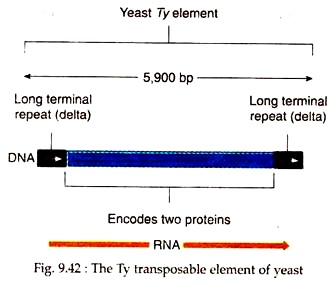In this article we will discuss about the transposable elements in yeast.
In yeast the transposable element is known as Ty element which is about 5-9 kb long and includes two directly repeated terminal sequences called long terminal repeats (LTR) or deltas (δ) (Fig. 9.42). Each delta contains a promoter and sequences that are recognized by transposase. The Ty element encodes a single 5,700 nucleotide long mRNA.
This mRNA begins with a promoter in the delta at the 5′ end of the element. This mRNA has two open reading frames (ORFs), designated as TyA and TyB which encode two different proteins required for transposition. In different strains of yeast, the number of Ty element varies and average number is 35 per strain.
ADVERTISEMENTS:
In fact, the organisation of yeast Ty element is very similar to the retrovirus. When a retrovirus infects a cell, its RNA genome is copied by viral reverse transcriptase, producing a double stranded DNA. This DNA integrates into host’s chromosome where it undergoes transcription to produce progency RNA viral genomes and mRNAs for viral proteins.
It is assumed that the Ty element transposes in a similar way like that of retroviruses that is not by DNA mechanism. It makes an RNA copy of the integrated DNA sequence and then creates a new Ty element by reverse transcriptase. This new element would then integrate at a site in the new chromosome.
Evidences in favour of such mechanism came from the experiments in which an intron was placed into the Ty element. This Ty element was then monitored from its initial position through the transposition event. The Ty element has no intron at its new location, indicating that its transposition occurred via an RNA intermediate. The imposed intron had been removed by normal splicing processes from the pre- mRNAs.
However, later on it was proved that Ty element encodes reverse transcriptase which show retrovirus-like activity in yeast cells. Since then, Ty element is also known as retro- transposons because of their similarity to retroviruses in this regard, and their transposition is called retro-transposition.
